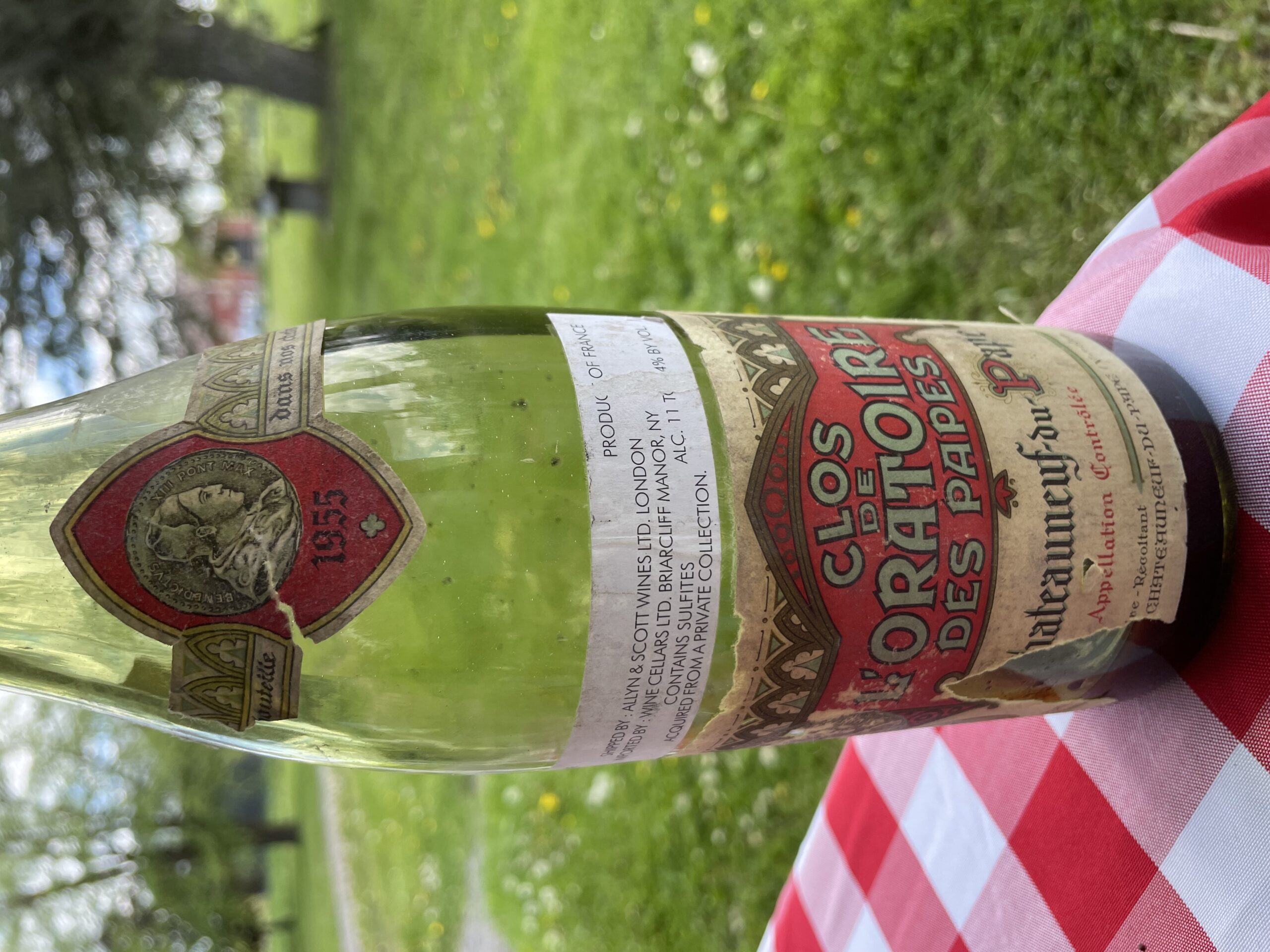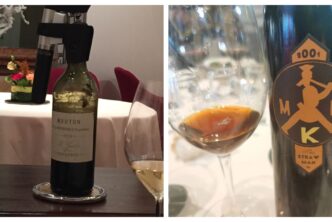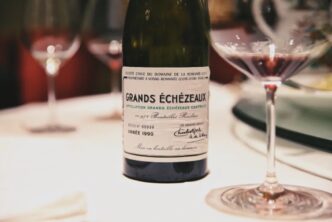Clos de l’Oratoire des Papes 1955 Chateauneuf-du-Pape 93
by Robert Millman

Due to the generosity and wine selecting skills of my friend Justin Christophe I was able to taste, blind, two masterpieces recently: The first was a 2001 JJ Prum Wehlener Sonnenuhr Spätlese from the great 2001 vintage. I guessed the wine but not its age. I will write a separate piece about this Mosel beauty. The red wine of the evening, well, that was another matter. Light in color but remarkably gleaming and bright, it was as fresh, vital and expressive on the palate as it was on the nose. The hue alone indicated that the wine had been in bottle for some time. It seemed decidedly younger in taste and smell. There was an engaging sweetness and floral energy to the bouquet which translated into to the taste and finish of the wine. There was little tannins but plenty of friendly acidity and lovely fruit intensity. This could not be a Cabernet or Merlot—that was obvious. Old Barolo? The truffles and autumnal earthiness were not in this wine. Perhaps an old Burgundy from a lighter terroir—Volnay perhaps? What else could it have been? Certainly not a Syrah from the northern Rhone. I failed to deduce that the wine might have been Grenache-based. Why? I do not think of older southern Rhones (with very few exceptions) making into old age in such spectacular fashion. My estimate was a wine of 30 years age.
I turned out to be the 1955 Clos de L’Oratoire des Papes Chateauneuf-du-Pape (the label did not carry the circumflex accent on the first ‘a’, as you can tell from the photo)! In other words, a mere 69 years old. I suspect the wine was delicious at ten years and developed an ageless plateau usually associated with left bank Bordeaux. In Robert Parker’s first edition of his book on the Wines of the Rhone he comments that “Thirty years ago this historic estate produced some of the most impressive wines of the appellation.” The quality of the property has declined into much less exciting wines since the 1980s—but that only emphasizes the poignancy of the splendid 1955. The youthful brilliance of this “old” wine is as amazing as it is difficult to explain. Drinking Window 2024–?? (perhaps 10 more years, but why wait).
Château d’Yquem 2021 Château d’Yquem Sauternes 97+

The 2021 Château d’Yquem is a superb wine, magically combining power, flesh, brightness of aroma and flavour and lightness of being. Bright deep golden yellow. Complex, deep aromas of tangerine jelly, peach, lemon curd, rose, crème brulée and beeswax, all complicated by marmelady botrytis on the captivating nose. Then fleshy and sweet in the mouth, with a grapey quality to the luscious and unctuous flavours of roasted banana, caramel, quince, peach, crystallized apricot and lemon curd. Very powerful, yet very elegant too: this is marvelous and it will undoubtedly improve further with more aging (hence the ‘+’ attached to my score). The aftertaste is long rich and dense, lingering long on the luscious palate. Memorable Yquem that is quite sweet (148 g/L residual sugar) but has plenty of crisp lemony acidity to make its seem light and lively on the palate leaving a beautifully penetrating impression on the aftertaste. Which is the main difference I find between it and the similar but slightly heavier-set 2005, for example; perhaps the 2021 is closer in style to the 1999 Yquem, though the 2021 is the more concentrated and deeper of the two. No matter: all three are amazing wines, but the 2021 has the advantage of being one of the better young Yquem in memory. Stellar stuff. Drinking window: 2028-2066.
The advent and increase of Sauvignon Blanc (both in plantings and in the wines) in Sauternes is one of modern wine’s major tragedies. To be crystal-clear, the only reason Sauvignon Blanc is gaining traction in the Sauternais (though happily, its advance appears to be slowing down of late, as locals begin to realize it might not have been a very bright idea to start with) is the consequence of an understandable attempt to make fresher, lighter-styled wines more in tune with modern lifestyles. I say “understandable” given the general belief that such lighter-bodied wines might prove easier to sell in this day and age when sweet wines are having a slightly tougher time on markets everywhere. However, increasing the Sauvignon percentage is, in my view at least, the wrong way by which to attain such a goal: this because it reduces the uniqueness of Sauternes wines, magnificent wines that are mostly, historically, Semillon-based. Besides the fact that Sauvignon Blanc does not blend as well with noble rot as does Semillon, reducing the latter’s presence in wines makes them less rich, unctuous and luscious. Add to that there is no other place in the world where Semillon gives results as grand as it does in Sauternes (Australia’s Hunter Valley’s Semillon wines can be magnificent but they are altogether different animals, while in South Africa everybody’s too busy shooting themselves in the foot by planting yet more Chardonnay) and you start to get a better picture of how things stand. And so, given that no other wine in the world comes even close to what Sauternes can deliver with its mostly Semillon wines, it seems to me (and not just to me) that losing such a diversity (and ultimately an advantage) to be, at best, a somewhat misguided act.
Château d’Yquem did not escape this fate: witness a steady increase in Sauvignon in its mix since the 1990s (the same has happened to Ygrec, the estate’s dry white wine: but in this case a little more Sauvignon in the mix is easier to understand and accept, and the wine is all-right by it) culminated with the less than successful 2019 Château d’Yquem, made with an essentially unheard proportion of Sauvignon Blanc – give or take 40% in its mix (don’t believe the many high scores lavished on it: it’s hard to even recognize the thing as an Yquem). Happily, with the 2021 the estate continues its circling back on its footsteps to a more normal 70% Semillon and 30% Sauvignon Blanc (which started already with the 2020, a 75/25 Semillon/Sauvignon mix). Frankly, the wine is all the better for it. (By the way, I wrote “normal”, but in fact 30% is still too much Sauvignon Blanc for this one-of-a-kind wine: historically Château d’Yquem, like all the better Sauternes, always had more Semillon than that in its mix.)
The 2021 Château d’Yquem is drop-dead gorgeous. It is also a clearcut example of the importance of terroir in wine. The 2021 vintage was a horrible one, in which Sauternes growing season was marred by untimely frost episodes so tough that some estates lost all their grapes; at other properties losses were less marked, but still the wineries made much less wine. At Yquem, thanks to the vineyards being situated the highest point of the Appellation, the frost damage was less than elsewhere, with only 15-20% of the total crop going lost. For example, while yields in Sauternes are usually very low all the time (for example, a paltry 25 hL/ha from 2015-2020), in 2021 the yields were barely above 5 hL/ha; at Yquem instead of the usual 10 hL/ha, they managed 8 hL/ha). Hail and rain added further difficulty, but for the most part the growing season, though cooler than previous ones, was characterized by a sunny, dry autumn that allowed the development of noble rot and good harvesting conditions. At Yquem they picked the grapes in three passes: the first before a period of shower activity of early October; the second pass took place in mid-October; and the third and last pass was carried out at the end of October. The resulting wine is a major achievement in such a tough vintage and speaks well of the talent and hard work of Yquem’s staff, expertly guided by long time director Pierre Lurton, one of the nicest, funniest and most knowledgeable men in all Bordeaux wine. Why, the 2021 Yquem actually showcases how a little more Sauvignon can have its place in the Sauternes mix, when well-dosed and tailored to the year’s characteristics: while the 2021 speaks clearly of its Semillon presence, it also boasts remarkable lightness of being, with a refreshing, penetrating quality that is absolutely thrilling. It’s not so hard to make a big, thick, rich sweet wine: it’s quite another to make one packing so much sweetness (148 g/L residual sugar in the 2021, similar to the 2017 d’Yquem) and yet be so impeccably balanced, refreshing and vivid at every sip. Well done! People have asked me what other Yquem vintages come to mind, but that’s a hard call: I know that similarities to the 2005 have been thrown around, but I personally believe that outstanding wine to be much thicker and fleshy than the more graceful 2021, which perhaps reminds me somewhat more of the 1999 Yquem, save for the fact that the 2021 is more luscious and concentrated.

 English
English

